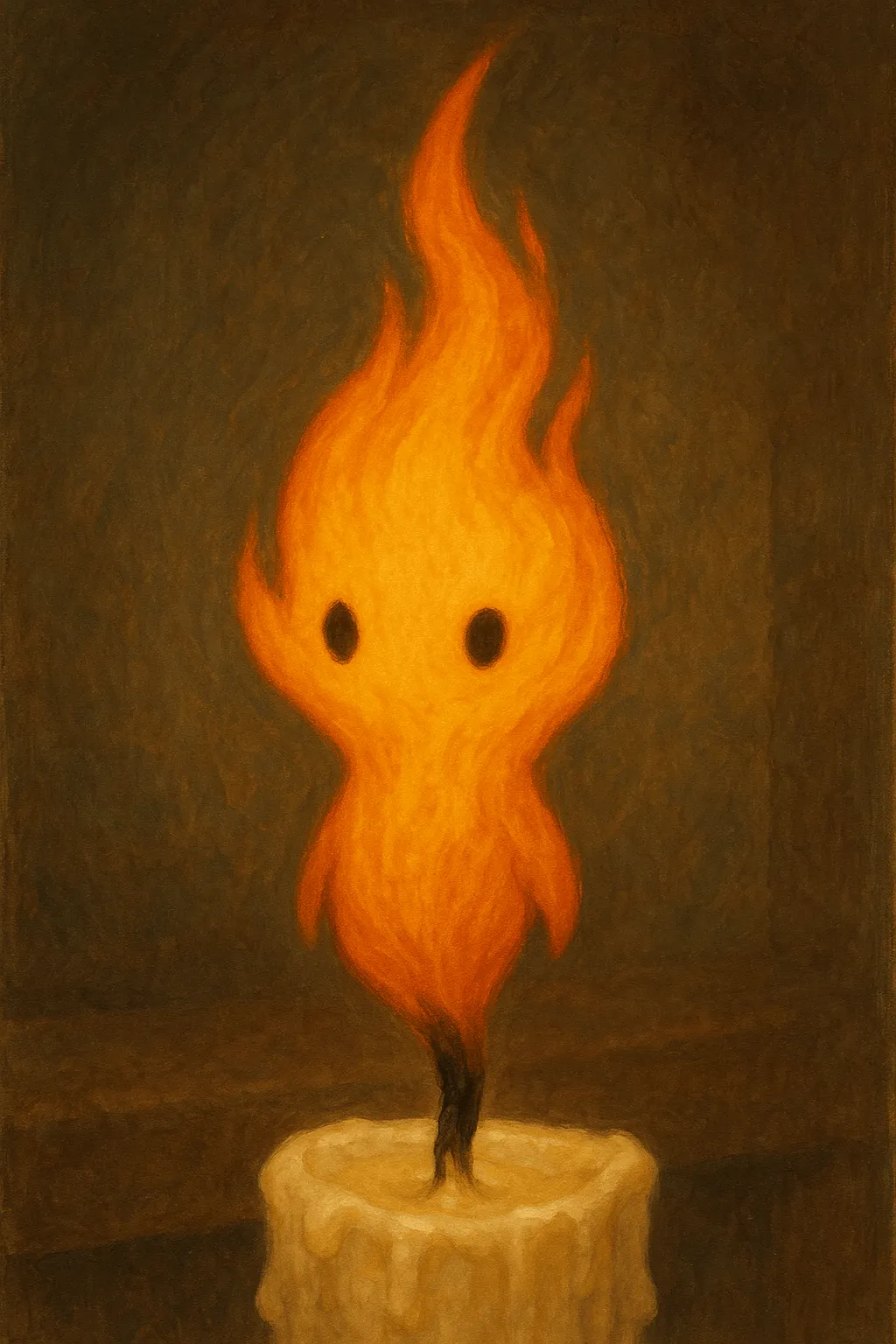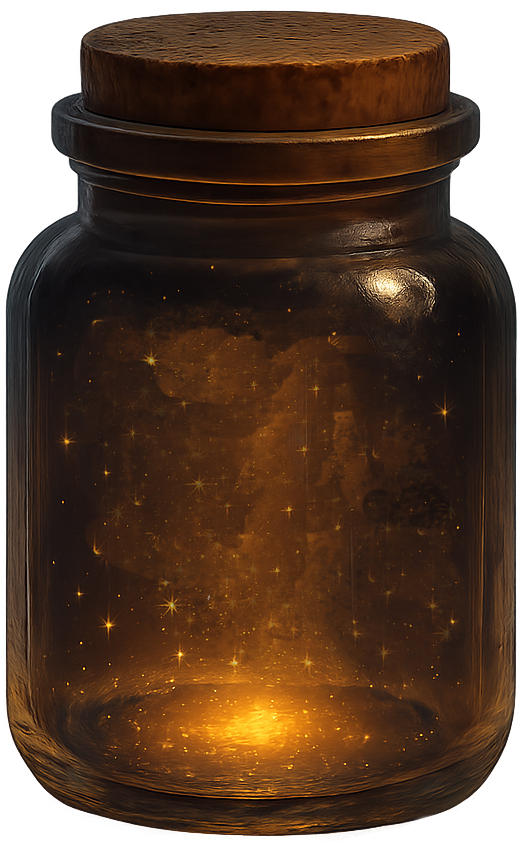
Some fires light the world. Others just watch it, quietly.
Elementals are not beasts, spirits, or gods—though they’ve been mistaken for all three. They are the living manifestations of the natural forces that shape the world. Born not from wombs or spells, but from pure essence, each elemental is a ripple in reality where one of the four primal forces—earth, air, water, or fire—has taken form. Some are vast and terrible, towering beings who stride across battlefields or storm through the sky. But others are small, nearly invisible to the inattentive eye, yet no less alive. Among these, the fire-aligned Cinder Wick is one of the most common and quietly fascinating.
 Roughly the size of a candle flame—because, in truth, it often is one—the Cinder Wick dwells near low, steady heat: hearths in village homes, devotional altars, sconce torches in castle halls, and the wax-stained desks of scribes who burn oil late into the night. It does not claim these flames as its own, nor does it spark them into being. Rather, it forms when the conditions are just right—when warmth, intent, and the lingering residue of presence coalesce. Where there is long-burning fire and patient ritual, a Wick may bloom into the world like a thought catching flame.
Roughly the size of a candle flame—because, in truth, it often is one—the Cinder Wick dwells near low, steady heat: hearths in village homes, devotional altars, sconce torches in castle halls, and the wax-stained desks of scribes who burn oil late into the night. It does not claim these flames as its own, nor does it spark them into being. Rather, it forms when the conditions are just right—when warmth, intent, and the lingering residue of presence coalesce. Where there is long-burning fire and patient ritual, a Wick may bloom into the world like a thought catching flame.
 Unlike the roaring fire elementals of battlefield legend, Cinder Wicks are peaceful creatures. They drift in silence, their flickers rarely noticed unless one knows to look for them. A Cinder Wick may hover above a wick without burning it, its body barely more than a shimmering coil of heat. When alone, it dances idly, mimicking the flame it shares space with. When watched, it sometimes pulses, as if aware. Scholars who’ve studied their behavior claim Cinder Wicks show mild preference for music, murmured prayers, or focused writing, often reacting to a change in rhythm or tone. They’re said to brighten when praised, and sulk when ignored for too long—though others argue this is projection more than proof.
Unlike the roaring fire elementals of battlefield legend, Cinder Wicks are peaceful creatures. They drift in silence, their flickers rarely noticed unless one knows to look for them. A Cinder Wick may hover above a wick without burning it, its body barely more than a shimmering coil of heat. When alone, it dances idly, mimicking the flame it shares space with. When watched, it sometimes pulses, as if aware. Scholars who’ve studied their behavior claim Cinder Wicks show mild preference for music, murmured prayers, or focused writing, often reacting to a change in rhythm or tone. They’re said to brighten when praised, and sulk when ignored for too long—though others argue this is projection more than proof.
 In magical theory, Cinder Wicks are considered pre-sentient—on the cusp of true consciousness but not quite there. They lack speech, goals, or a desire to grow, yet they clearly recognize heat sources, familiar voices, and spatial boundaries. This has led to their cautious adoption as familiars among hedge witches and lesser pyromancers. When properly coaxed, a Cinder Wick can light a lantern without striking flint, or keep coals smoldering through a long winter’s night. Some say they ward off lesser spirits of cold and shadow, though that may be poetic fancy.
In magical theory, Cinder Wicks are considered pre-sentient—on the cusp of true consciousness but not quite there. They lack speech, goals, or a desire to grow, yet they clearly recognize heat sources, familiar voices, and spatial boundaries. This has led to their cautious adoption as familiars among hedge witches and lesser pyromancers. When properly coaxed, a Cinder Wick can light a lantern without striking flint, or keep coals smoldering through a long winter’s night. Some say they ward off lesser spirits of cold and shadow, though that may be poetic fancy.
 Mythologically, Wicks occupy an interesting niche. They are not feared like wildfire spirits, nor revered like the great Flame Heralds of the southern deserts. Instead, they are associated with home, habit, and small-but-steady devotion. In old village traditions, it is said that if a household flame burns cleanly for nine nights without extinguishing, a Cinder Wick will take root and guard the home from harm. This belief has led to certain rural customs—such as placing milk or honey near hearths during festivals, not for any god, but for “the flame that watches.”
Mythologically, Wicks occupy an interesting niche. They are not feared like wildfire spirits, nor revered like the great Flame Heralds of the southern deserts. Instead, they are associated with home, habit, and small-but-steady devotion. In old village traditions, it is said that if a household flame burns cleanly for nine nights without extinguishing, a Cinder Wick will take root and guard the home from harm. This belief has led to certain rural customs—such as placing milk or honey near hearths during festivals, not for any god, but for “the flame that watches.”
 Cinder Wicks are deeply entwined with the concept of intent heat—fire not meant for destruction, but for purpose. A battlefield blaze rarely draws them; a temple candle nearly always will. In this way, they have become symbols of focus and inner light, especially among mendicant monks and scholars of elemental balance. In the northern monasteries, flickering Wicks are believed to test a novice’s patience: those who remain still and meditative in their presence are thought to receive clearer insight in dreams.
Cinder Wicks are deeply entwined with the concept of intent heat—fire not meant for destruction, but for purpose. A battlefield blaze rarely draws them; a temple candle nearly always will. In this way, they have become symbols of focus and inner light, especially among mendicant monks and scholars of elemental balance. In the northern monasteries, flickering Wicks are believed to test a novice’s patience: those who remain still and meditative in their presence are thought to receive clearer insight in dreams.
 It is rare for a Wick to grow beyond its form, but not unheard of. Ancient tales speak of fire mages who nurtured a single Wick for years, feeding it incense, story, and song until it grew into a companion of brilliant, ember-skinned grace. Others caution that even the smallest fire spirit, when wounded or abandoned, may spiral into a rogue emberling—a mischievous spark capable of igniting scrolls and curtains out of spite.
It is rare for a Wick to grow beyond its form, but not unheard of. Ancient tales speak of fire mages who nurtured a single Wick for years, feeding it incense, story, and song until it grew into a companion of brilliant, ember-skinned grace. Others caution that even the smallest fire spirit, when wounded or abandoned, may spiral into a rogue emberling—a mischievous spark capable of igniting scrolls and curtains out of spite.
Though harmless by most standards, a Cinder Wick’s presence is never meaningless. It is a living warmth, a whisper of flame made aware. Where it lingers, something is being remembered, tended, or studied. And where it fades, something once precious may be slipping quietly into ash.
The following magical heirlooms are fictional and lore-based in nature. Each one is an affiliate link to a real-world item on Amazon that we've hand-selected to complement this artifact's lore.


If you click a link and buy an item, we may earn a commission.It costs you nothing extra, but can help keep this little corner of the internet glowing.
What does this mean?
A jar containing magical glowing wisps that follow the owner, lighting their surroundings.

For when you need to mobile and comfy and the same time. Also smores.

Emits steady daylight in shadowed paths. Follows its attuned bearer.

A floating, sometimes grumpy, tome that hovers behind and takes notes for you.





